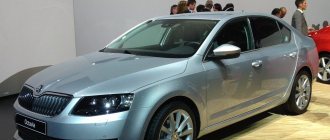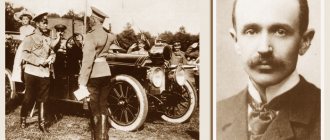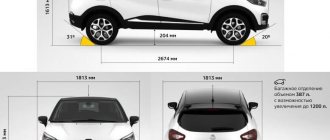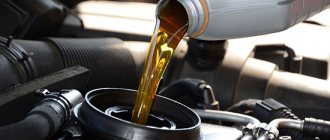Skoda Octavia firmly holds its position in the automobile market. Since the time of the first model in this series, the car has firmly established itself in the top of the most purchased cars in Russia and the CIS countries. Therefore, it has earned the status of a “people’s” car. Both a young guy and a retired summer resident can sit behind the wheel. In the A5 model, Skoda tried to correct the inaccuracies and defects that were present in the Tour, and emphasize the advantages. We will look at how the name “A5” influenced the technical characteristics of the Skoda, and also take a quick look at the design and interior features of the new Skoda.
Octavia A5 is a five-seat C class liftback. This generation has been on the market since 2004. A light update was carried out in 2009. The car is produced on the VAG platform (SEAT Leon, Golf and others are also produced here). Octavia also received a station wagon - A5 Combi. This time we were not deprived and were given a choice of as many as 2 diesel and 3 gasoline engines.
Petrol units with a volume of 1.8 and 1.6 are available in the Elegance and Ambiente configurations. For the same trim levels, two diesel engines are available – 2.0 TDI and 1.9 TDI. The two-liter TFSI petrol engine with turbines is only available in the sports version of the Octavia RS. The standard gearbox for all engines is a 5-speed manual. The version with the 1.6 MPi engine can be equipped with a 6-speed automatic transmission, the 1.8 TSI with a 7-speed DSG. The sports Skoda A5 comes strictly with a manual transmission, the 2.0 TDI has a choice of manual or automatic.
Car in action
You can consider the technical characteristics of the A5 using the example of the version with the 1.4 engine. Firstly, despite the low power, the motor has excellent elasticity: the traction torque is in the range from 1500 to 4000 rpm. At the same time, most of the torque is kept in the lower rev range. Such indicators are relevant on city roads, because with such a moment the reaction between the pedal and the engine occurs instantly. If you need to quickly “jump” to the next row, this characteristic will help with such a maneuver. This engine outperforms the naturally aspirated 1.6, which is the youngest in the range, because the naturally aspirated engine starts working fully only at 4000 rpm.
But the faster the tachometer needle approaches the red line, the faster the advantages of a turbocharged engine “melt away”. However, a modern gearbox, which has as many as 7 gears in its arsenal, does not allow the engine to “fall asleep”. The engineers have established an excellent balance between the gearbox and the engine. The automatic transmission shifts sharply. The peculiarity of the machine is that it can go up faster than go down. With a “ragged” ride, the DSG quite clearly “stumbles” when moving from higher gears to lower ones.
Probably the first factor when choosing a car in Russia is its efficiency parameters. And here the engine, which operates in the lower rev range, shows pleasant results. During tests, when the car drove about 400 kilometers, the engine “ate” only 26 liters of fuel. These figures clearly show that the Octavia A5 is perfect for family trips.
Technical characteristics of Skoda Octavia A5, A6 2nd generation. Dimensions of Octavia A5
Trunk capacity and dimensions of the Skoda Octavia A5 |
There was a question here: tell me, does a baby stroller fit into the trunk of a Skoda A5?
The information will be useful to those who are planning to transport large items in the trunk of a Skoda.
The other day I was wondering whether everything that needs to be transported would fit in. I couldn’t find it in the instruction manual, I wanted to go and measure it.
I went online and found a very clear photo indicating the dimensions.
So,
trunk volume 585 l.
Skoda trunk rules
www.avtopol-msk.ru
Technical characteristics of Skoda Octavia A5 / Skoda Octavia 2012
Below are the main technical characteristics of the Skoda Octavia A5 / Skoda Octavia 2012.
Body
| Body type | hatchback |
| Car class | C class |
| Length / width / height, mm | 4569 / 1769 / 1462 |
| Wheelbase, mm | 2578 |
| Ground clearance (ground clearance), mm | 164 |
| Trunk volume, l | 560 |
| Curb weight, kg | 1180 |
| Fuel tank volume, l | 55 |
Engine and transmission
| engine's type | petrol | petrol | petrol | petrol |
| Volume, l | 1,4 | 1,6 | 1,6 | 1,4 |
| Power, hp | 80 | 102 | 102 | 122 |
| Torque, Nm | 132 | 153 | 153 | 200 |
| Gearbox type | Mechanics | Mechanics | machine | Mechanics |
| Number of gears | 5 | 5 | 6 | 6 |
| Drive unit | front | front | front | front |
| Acceleration 0-100 km/h, s | 14,2 | 12,3 | 14,1 | 9,7 |
| Max speed, km/h | 173 | 190 | 174 | 202 |
| Fuel consumption, l | ||||
| - city | 9,6 | 10,0 | 11,2 | 8,5 |
| - track | 5,6 | 5,8 | 6,1 | 5,0 |
| - mixed | 7,0 | 7,4 | 7,9 | 6,3 |
| engine's type | petrol | petrol | petrol |
| Volume, l | 1,4 | 1,8 | 1,8 |
| Power, hp | 122 | 152 | 152 |
| Torque, Nm | 200 | 250 | 250 |
| Gearbox type | robot | Mechanics | machine |
| Number of gears | 7 | 6 | 6 |
| Drive unit | front | front | front |
| Acceleration 0-100 km/h, s | 9,7 | 8,1 | 8,8 |
| Max speed, km/h | 202 | 219 | 214 |
| Fuel consumption, l | |||
| - city | 8,0 | 9,5 | 10,8 |
| - track | 5,3 | 5,5 | 5,9 |
| - mixed | 6,3 | 6,9 | 7,7 |
roadres.com
Skoda Octavia A5 review: Big-eyed octave
In addition to larger and more expressive front optics, the externally updated Octavia A5 is distinguished by a front bumper with a larger central air intake and modified foglights, a rear bumper with red reflectors, a different radiator grille and turn signal repeaters in the rear-view mirrors. All these changes have noticeably refreshed the appearance of the model, and it seems larger and more representative.
2004-2008 – A pre-restyling version of the Skoda Octavia A5 was produced.
08.08 – Modernization of Octavia A5. The installation of new gasoline engines has begun: 1.4 l TSI (122 hp) and 1.8 l TSI (160 hp), which replaced the naturally aspirated 2.0 l FSI unit (150 hp).03.10 – The engine range has been supplemented with a 1.2 liter 16V TSI petrol engine (105 hp) and a 1.6 liter turbodiesel (105 hp). Officially, such versions were not sold in Ukraine. 12.12 – The next, third generation of Skoda Octavia in the A7 body was presented.
Native citizenship
All Octavia A5s were assembled using the large-knot method in Ukraine at Solomonovo.
The model has three modifications: the liftback, which is most widely used in our country, the Combi station wagon and its pseudo-off-road version Scout. A “charged” version of the RS with powerful turbocharged engines was intended for active drivers: 2.0 liter petrol (200 hp) and 2.0 liter diesel (170 hp). The RS was produced in two body styles, but we only have liftbacks and a petrol version. Since we considered the Scout modification separately (“AC” No. 52'2012), today we’ll talk about the qualities of the other versions.
The practical Combi station wagon is less common than the more popular liftback, although it is quite possible to find it on the secondary market.
Octavia A5 bodies are well protected from corrosion. In addition, in the updated car, the designers modernized the seals on the doors, which in earlier versions, over time, rubbed the paint down to metal and provoked the appearance of rust. Of the body parts, the front fog lights should be criticized - they sometimes sweat, and the running light bulbs are short-lived. Marked
Dimensions and other characteristics of the hardware
Another important point was the changed dimensions of the Skoda Octavia A5, here’s what happened:
- Length: 4569 mm;
- Width: 1769 mm;
- Height: 1462 mm;
- Ground clearance is 164 mm;
- The Skoda A5 weighs 1350 kilograms (the Skoda Octavia RS weighs 100 kg more);
- The trunk volume here is 560 liters.
These figures indicate that Skoda has become smaller and more practical. The body type has not changed - it is still a liftback with 5 doors and 5 seats. The curb weight reaches almost 2 tons. The fuel tank holds 55 liters. The Skoda Octavia A5 has received one of the best environmental standards in Europe - Euro IV.
As for the suspensions, the Skoda A5 has leaf springs, an anti-roll bar, a shock absorber strut, coil springs and wishbones at the front. The rear suspension is multi-link, which works in conjunction with an anti-roll bar.
The braking system in the Skoda A5 is very reliable by 2014 standards: rear disc brakes and ventilated front disc brakes. Skoda did not overdo it with the electronic amplifier - the steering wheel responds well, the turning circle is 10.85. The maximum speed that the Skoda A5 can reach is 223 km/h. The car accelerates to 100 kilometers in 8 seconds.
The tests showed the following results on fuel consumption:
- In the mixed cycle, the Skoda Octavia eats 7 liters. per 100 kilometers, respectively;
- In the city - 10.1 liters;
- On a suburban highway, the Skoda A5 spends only 5.9 liters.
Engines
Gasoline versions
| Version | 1.4 16V | 1.4 16V | 1.2TSI | 1.4TSI | 1.6 8V |
| Start of sales | 2004 | 2007 | 2010 | 2008 | 2004 |
| Engine | petrol | petrol | benz, turbo | benz, turbo | petrol |
| Working volume | 1390 cm3 | 1390 cm3 | 1197 cm3 | 1390 cm3 | 1595 cm3 |
| Cylinder/Valve Arrangement | R4/16 | R4/16 | R4/16 | R4/16 | R 4/8 |
| Maximum power | 75 hp | 80 hp | 105 hp | 122 hp | 102 hp |
| Maximum torque | 126 Nm | 132 Nm | 175 Nm | 200 Nm | 148 Nm |
| Dynamics | |||||
| Maximum speed | 170 km/h | 173 km/h | 192 km/h | 203 km/h | 190 km/h |
| Acceleration 0-100 km/h | 15.5 sec | 14.2 sec | 10.8 sec | 9.7 sec | 12.3 sec |
| Average fuel consumption in l/100 km | 7,0 | 7,1 | 6,0 | 6,6 | 7,4 |
1.4 l
1.4 MPI with 75 and 80 hp were intended to reduce the initial cost of the base car. Among the shortcomings are problems with the lubrication system and crankcase ventilation. They are not of great interest on the secondary market.
1.2TSI
They went on sale not so long ago, so many copies with this engine have low mileage. A very economical and surprisingly flexible unit. However, it has problems with the timing chain.
1.4TSI
This is an unreliable unit. The engine has direct injection, turbocharging and problems with the timing chain drive. However, the technical characteristics of the motor are excellent. After 100-150 thousand km, the wastegate valve stem jams - the mechanism and bushing wear out. The cost of an official repair kit starts from 30,000 rubles, but many services have learned how to repair a faulty unit.
1.6 l
If anyone is counting money and is wary of high maintenance costs, then this is the engine for you. It has low performance, but is more reliable than others. Among the characteristic weak points are fuel injectors (150-250 thousand km / from 8,000 rubles) and an increase in oil consumption after 100-200 thousand km (replacement of valve stem seals and rings is necessary).
| Version | 1.6 FSI | 1.8TFSI | 2.0 FSI | 2.0TFSI |
| Start of sales | 2004 | 2007 | 2010 | 2008 |
| Engine | petrol | benz, turbo | petrol | benz, turbo |
| Working volume | 1598 cm3 | 1798 cm3 | 1984 cm3 | 1984 cm3 |
| Cylinder/Valve Arrangement | R4/16 | R4/16 | R4/16 | R4/16 |
| Maximum power | 115 hp | 160 hp | 150 hp | 200 hp |
| Maximum torque | 155 Nm | 250 Nm | 200 Nm | 280 Nm |
| Dynamics | ||||
| Maximum speed | 198 km/h | 223 km/h | 213 km/h | 240 km/h |
| Acceleration 0-100 km/h | 11.2 sec | 7.8 sec | 9.3 sec | 7.3 sec |
| Average fuel consumption in l/100 km | 6,7 | 7,1 | 7,2 | 7,5 |
1.6 FSI
FSI and TFSI engines are an ideal option when it comes to buying a new car from a showroom. They are not durable and after 150,000 km they often begin to cause problems. 1.6 FSI with direct injection and timing chain drive is slightly more expensive to maintain.
Early FSI engines tended to develop increased carbon deposits. The result: a drop in power, uneven operation and, in extreme cases, damage to the cylinder head elements and pistons. Carbon deposits are best removed mechanically. But you can also try chemical ones, although a positive result is not guaranteed.
1.8 TSI and TFSI
It is the successor to the older 1.8T and impresses with its performance, flexibility and efficiency. However, a turbo engine is expensive to maintain. In addition, after 100-150 thousand km, the chain may stretch. Engines assembled before the end of 2011 suffered from high oil consumption, to eliminate which it was necessary to change the piston (20-50 thousand rubles).
2.0 FSI
Quite a good engine with direct fuel injection. At high mileage, carbon deposits form in the intake manifold.
Diesel versions
| Version | 1.6 TDI CR | 1.9 TDI | 2.0 TDI | 2.0 TDI | 2.0 TDI CR |
| Start of sales | 2009 | 2004 | 2004 | 2005 | 2009 |
| Engine | turbodies | turbodies | turbodies | turbodies | turbodies |
| Working volume | 1598 cm3 | 1896 cm3 | 1968 cm3 | 1968 cm3 | 1968 cm3 |
| Cylinder/Valve Arrangement | R4/16 | R 4/8 | R4/16 | R4/16 | R4/16 |
| Maximum power | 105 hp | 105 hp | 140 hp | 170 hp | 170 hp |
| Maximum torque | 250 Nm | 250 Nm | 320 Nm | 350 Nm | 350 Nm |
| Dynamics | |||||
| Maximum speed | 190 km/h | 192 km/h | 208 km/h | 225 km/h | 225 km/h |
| Acceleration 0-100 km/h | 11.8 sec | 11.7 sec | 9.6 sec | 8.5 sec | 8.5 sec |
| Average fuel consumption in l/100 km | 4.8 | 5.1 | 5.5 | 5.8 | 6.0 |
1.6 TD CR.
A very economical and fairly reliable engine with a Common Rail power system. Thanks to its excellent efficiency, it came under the hood of the environmentally friendly “Greenline” version.
1.9 TDI.
Taking into account the costs of fuel consumption and maintenance, this is the cheapest engine to operate. The power is not great, but the torque is high.
2.0 TDI.
The old version of the turbodiesel with pump injectors is extremely unreliable - it is better to avoid it. Only the new engine with the Common Rail injection system deserves attention.
Bottom line
Octavia A5 leaves only positive impressions. Balance in everything – decent technical indicators for a family leftback and a high-quality interior. Skoda still holds the brand and one of the first places in the sales ranking, and this is not surprising - a reliable and high-quality car will always be in price.
Tuning your car - Skoda Octavia If you are the owner of a Skoda Octavia, then sooner or later you will have a desire to improve your car.… Characteristics of the improved Skoda - Octavia RS The Skoda Octavia RS car became the direct successor to the Octavia. The predecessor was recognized as the best station wagon of 2005 by German motorists and demanding British.… The Skoda Octavia station wagon is a roomy passenger car. There are enough lovers and even fans of Skoda cars in Russia. And this is quite understandable. After all, Skoda has repeatedly become a leader in...
Previous articles:
Luggage compartment features
The Skoda Octavia stands out among other cars with the most spacious trunk in its class. The rear seat backs fold down to increase space in the luggage compartment. If we take the average volume of 548 liters, then with the seats folded the owner will receive 1548 liters, which will allow you to place even a small wardrobe there. The lid has a wide opening, making loading and unloading easy.
The average length is 112 cm. The height of the compartment is 69 cm, which is greater than that of other classmates. The trunk has special straps inside to secure the cargo. They will be able to protect objects from falling when turning and eliminate debris.
As for the functional and versatile trunk options, the Skoda Octavia Combi has 610 liters in the normal version and 1740 with the seats folded, which makes it easy to use the cargo transportation function. The same can be said about Octavia Scout, which has similar performance.
Considering the advantages of the issue under discussion, the car is suitable for families to go on vacation, travel or to nature. It is worth considering the parameters of each generation, which will allow you to make the right choice.











